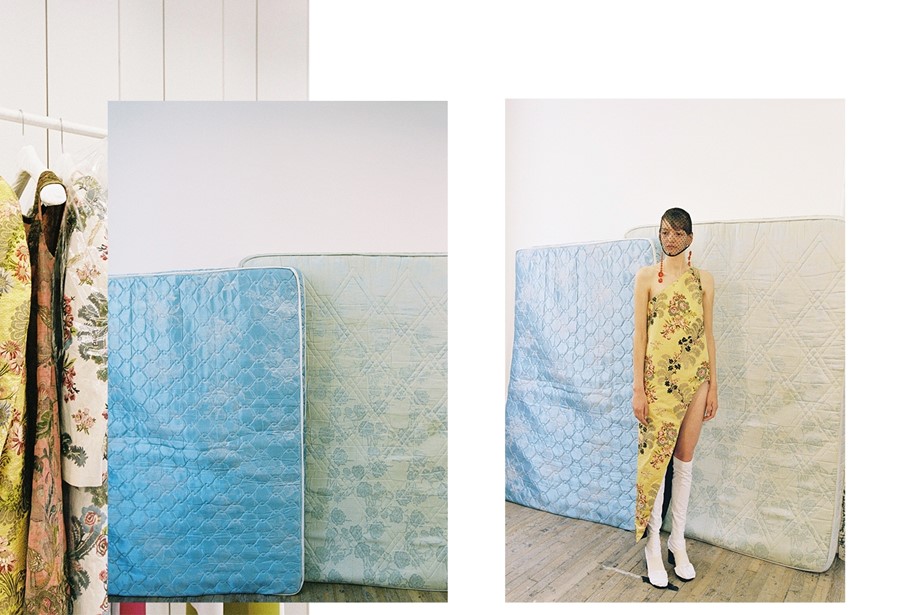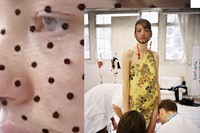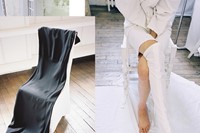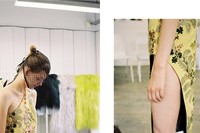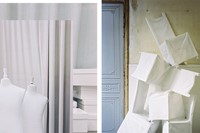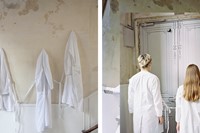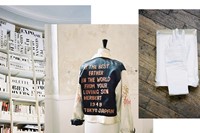An exclusive Insiders look at the Maison Martin Margiela atelier during couture, with exclusive photographic collages by HART+LËSHKINA
As the winter couture season drew to a close in Paris, there was one common thread to the best shows of the season: a desire to make couture – that most rarefied, extravagant art of dressmaking, typically available only to an exalted few – relevant to today’s woman. Specifically how can one take the best of the past and apply it in a way that seems modern and grounded in reality? And if Maison Martin Margiela Artisanal might seem an unlikely candidate – it is only in its fifth showing on the official haute couture schedule and its stated mission is to reuse, recycle and reinvent – it’s also one that the Maison is uniquely poised to answer. Japanese souvenir bomber jackets, 18th century silk lampas, old French francs, bottle tops – the laundry list of raw ingredients that make up a Margiela Artisanal collection sound more like the humble detritus of a particularly eccentric collector than the traditionally luxe materials of an haute couture show. And yet by the time the alchemists at the atelier are done breathing new life into them, the flotsam and jetsam are reconfigured into something beautiful and romantic.
The journey from trash to treasure begins at the Margiela atelier in the 11th arrondissement in Paris. Fittingly for a brand adept at metamorphosis, the building has undergone many incarnations – originally built as a convent, it has also been an orphanage and from the 1920s, a private industrial-design school. When team Margiela moved in eight years ago, the building had been abandoned for nearly 15 years. The Maison inform us they kept the building and interior close to how they discovered it. And yet, everything from the chandelier covered in voile, the neon ‘Welcome’ sign, the receptionist sitting at a supermarket checkout counter, to the fact that all surfaces are shrouded in a lightly scuffed white fabric, is proof that we are unmistakably in the world of Maison Martin Margiela.
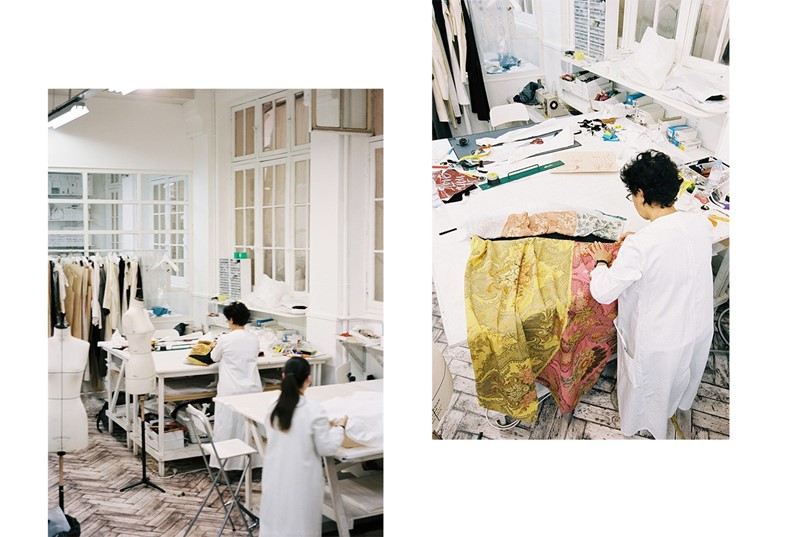
And what a surreal and subtly enticing world it is. While the designer himself, who started the label in 1989 may have departed from the brand that bears his name, the entirely new vocabulary he wrote for clothing remains intact. In the two decades and more since its inception, Margiela has been responsible for many of the most touchingly beautiful and wittily intelligent fashion statements of all time. Trompe l’œil, deconstruction, the reversed dart-and-seams, the paint splattered surfaces and unfinished edges, the Margiela shoulder, the Tabi-toed boots and most of all, Margiela’s skill at ‘bricolage’ – the repurposing and re-appropriation of found pieces and objects – the very foundation of the Margiela Artisanal line.
"Since its inception, Margiela has been responsible for many of the most touchingly beautiful and wittily intelligent fashion statements of all time"
Winding our way through the maze of corridors, staircases and eerily deserted rooms, we finally make our way to the atelier itself where a young team of artisans, all outfitted with the standard blouse blanche of the Maison are at work on the Artisanal collection. With a mix of classical music and hip hop blasting in the background, the team bustle around a veiled model in an asymmetrical one shoulder dress made out of Frank Lloyd Wright fabrics, photographing her against a backdrop of upturned mattresses. Suffice it to say, this is unlike any other couture salon. On a table is arrayed a variety of delicate veils and the by-now iconic jewelled masks made infamous by Kanye West. In another corner, an aluminium party balloon saying ‘I LOVE YOU’ is rendered in crystal embroidery to become a backless bustier. Amid the breath-taking ingenuity though, there is genuine emotion. Nowhere is this more apparent than in the Japanese souvenir bomber jacket turned into an evening jacket with its original inscription intact, “To The Best Father In The World From Your Loving Son Herbert 1949 Tokyo Japan”. The Maison tell us these jackets were souvenirs of occupying troops in Japan who took their own jackets to local tailors to get them embroidered with Japanese motifs. To see this once loved family heirloom “erased and re-coloured” is to get a sense of what Margiela Artisanal are trying to achieve here – transmitting the meaning and value of clothes across the generations. “We think it’s poetic,” the Maison informs us. Yes, and not a little bit melancholic and elegiac too.
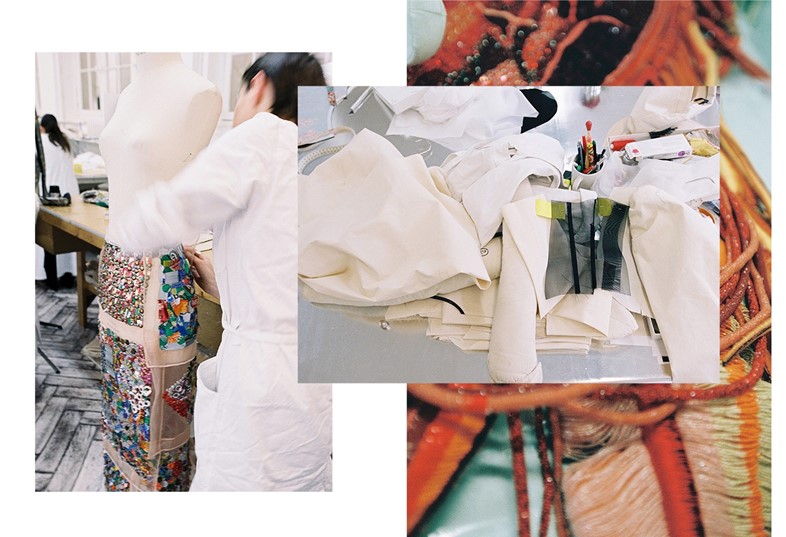
And while the last season was about ‘obsessive collectors’, this season they inform us, “is specifically about couture. We want to take the essentials of what you know about couture and turn it inside out”. Which is how a beautiful Regency-inspired brocade coat by Paul Poiret is paired with a gypsy skirt of jangling coins or how a three-dimensional embroidery depicting a blue lobster (a nod to Elsa Schiaparelli) is worn as a shawl over a couture bustier. While Margiela shownotes fetishistically detail the production time and materials that create each look, this show was as much about exposing the painstaking, handmade processes of couture. As the Maison state it, the collection was revisiting a collective memory of couture – “disassembled and reassembled in strata of periods, iconic places and images, it is recomposed like an exquisite corpse.”
At the show the next day, held in an industrial space in the 10th arrondissement, is when this irresistible, idiosyncratic vision of couture comes alive. The show opened with the most recognisably Margiela look – a simple white shirt accessorized with 1940s jewellery by Line Vautrin – a contemporary of Schiaparelli who was famed for her neo-romantic work. The most compelling example of the atelier's couture workmanship comes in the exquisite shift dress made out of an assemblage of iris embroideries, echoing Van Gogh’s most famous paintings. The show ended with an elegant coda of evening dresses collaged from various vintage fabrics sourced from private auctions and flea markets around the world. Here then was the genius of the Margiela Artisanal collective on full display – by ripping up the rule book, by celebrating and elevating what might have otherwise been forgotten, they were upending couture’s traditions but at the same time honouring them. As we leave the show space, emerging out under the cool gray skies of Paris, the haunting loveliness of the show and our last two days with the Maison stays with us. Rich with stories and emotions, these were clothes made with love that still retain the power to surprise and inspire and ultimately to seduce. And what could be more true to the raison d’etre of couture than that?
Text by Kin Woo
Photographic Collages by HART+LËSHKINA
Creative Direction by Laura Bradley, Agata Belcen and Zoe Klang
With special thanks to Maison Martin Margiela and Michael Dulce
